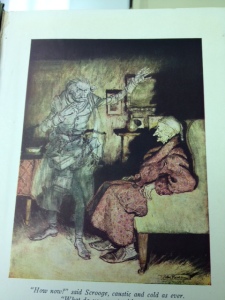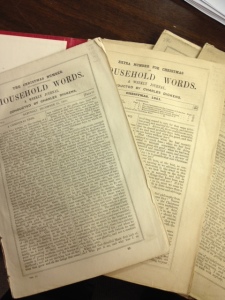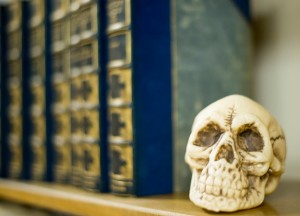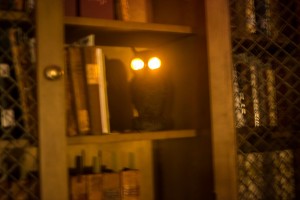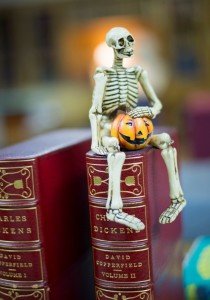Dubbed “the man who invented Christmas” by the London Times Supplement, Charles Dickens certainly captured the hearts and imagination of many generations with his wonderful novella, A Christmas Carol. Few people are not familiar with the story of the bitter old miser who through ghostly intervention comes to understand the joy of the season. You can find examples of this work in the Galvin Rare Book Room, illustrated by either Gustav Dore or Arthur Rackham.
In 1850, Dickens started his own publication—Household Words. The title was taken from Shakespeare’s Henry V’s speech, “Familiar in their Mouths as household words”. The thin publication cost two pennies with no advertisements or illustrations. With the running header, “Conducted by Charles Dickens”, the journal printed original stories and crusading social journalism. Dickens published Hard Times and A Child’s History of England in the journal along with almost 200 solo articles, stories, poems and “chips” (short satirical pieces). There were also more than 380 other contributors, 90 of whom were women like Elizabeth Gaskell. Wilke Collins, Henry Morley, and a host of unnamed writers writing in a Dickensian style filled the pages of the journal every Saturday from 1850 to 1859.
And come December, there was always a Christmas Edition with special stories and articles just for the season. Dickens contributed “The Christmas Tree” to the first “Christmas Number” followed by unattributed stories such as “Christmas in Lodgings” or “Christmas in the Navy”. By 1852, the Christmas number became “A Round of Stories by the Christmas Fire” and finally the number carried the name of the leading story in the journal. Each story and poem chronicled Victorian life with all its light and dark moments, as so much of Dickens work did.
Come by the Galvin Rare Book Room and take a look at our collection of Christmas numbers of Household Words. We guarantee it’s no humbug.

